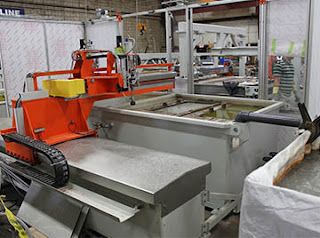The Importance of Taking Care of Your Stained Glass Equipment
Your glass cutter, an essential tool, is the one tool you constantly use and needs to work properly to insure proper and accurate cutting. One of the easiest and important things you need to do with your cutter is store it in a container partially filled with lubricant that covers the bottom of the jar and the wheel. It's a good idea to pad the bottom of the jar with a piece of cloth or paper towel. This will keep the cutter wheel lubricated and avoid the wheel from freezing which can ruin the cutter. Never leave the cutter sitting out on your workbench. It is a good idea to get into the habit of putting the cutter back into the storage jar each time you finish cutting.
Glass lubricant is an oil that is usually a mixture of kerosene and light oil. The lubricant cleans off little slivers of glass that tend to cling to the wheel. These slivers of glass can interfere with the rotation of the wheel. Another advantage of the lubricant is how it helps prevent score lines from sealing. A bottle of this lubricant can be purchased at your local stained glass retail store, it is inexpensive and will last for a long time.
When you score stained glass, don't go over score lines. This will dull the wheel. Always dip the wheel in lubricant before each score if it is not self-lubricating. Running your wheel off the edge of the glass will shorten its life, too. Stop your score 1/8" from the glass edge.
If you have to use excessive pressure (over 15 lbs of force) the cutting wheel may be dull and needs replacing. If your score lines look more like a dotted line, the cutting wheel may be dented and again should be replaced.
With proper care and maintenance your stained glass cutter will serve you well for a long time.
While soldering, use a clean wet sponge or metal mesh cleansing pad to keep the hot iron tip free of dirt. This should be done periodically.
Before turning off your iron, be sure to clean the tip and then re-coat it with a thin coat of solder. This is referred to as re-tinning.
If your iron has carbon built up on it, use a tinning block of aluminum chloride, that will remove any built up carbon. Be sure to follow manufacturer's directions.
Some irons require loosening the set screw located near the tip of the iron. This is done to prevent the iron tip from freezing in the shaft. It is a good idea to brush off any scales from the shank. Always read accompanying instructions that came with your iron.
Never leave your soldering iron on when not in use.
Before installing diamond grinding head on the grinder's shaft, lubricate the shaft and set screw with an anti-seize lubricate. This should be done every time you clean the grinder.
Not using an anti-seize lubricate can result in the diamond head freezing onto the grinder shaft. This can be almost impossible to remove and will in effect ruin the grinder.
Fill the water trough with cool water to the manufacturer's indicated level. Then add 3 to 4 capfuls of grinder coolant to the water. This will extend the life of your diamond grinding heads.
As you use your grinder, periodically check the water trough. As you see a build up of glass residue in the water trough, stop and clean your grinder.


Comments
Post a Comment